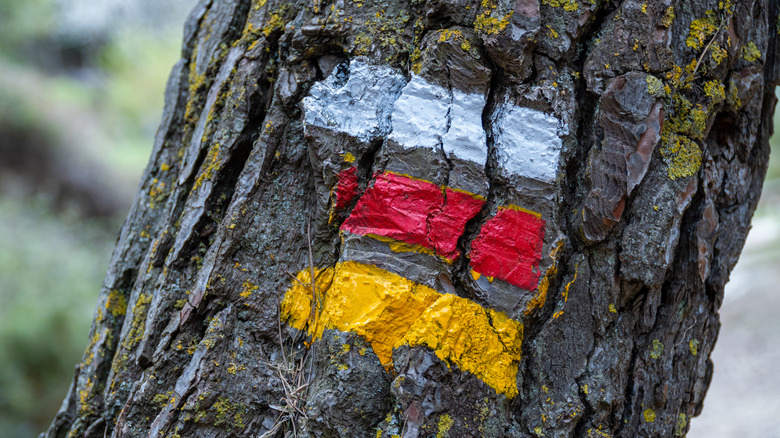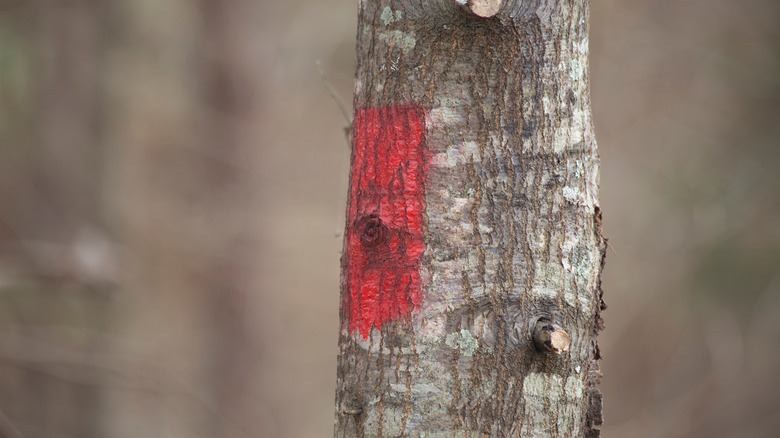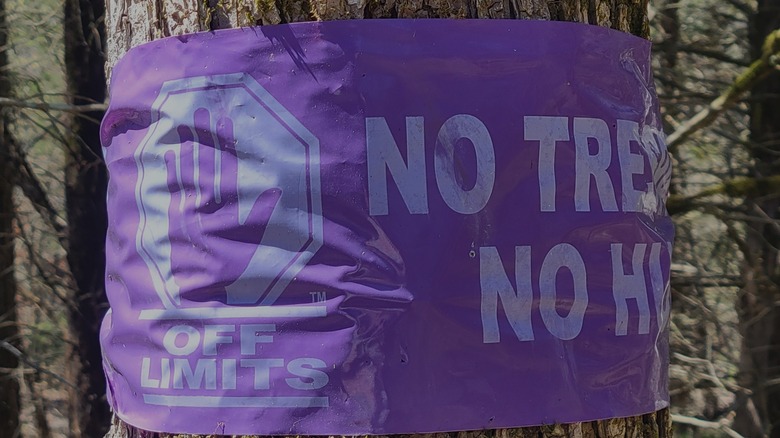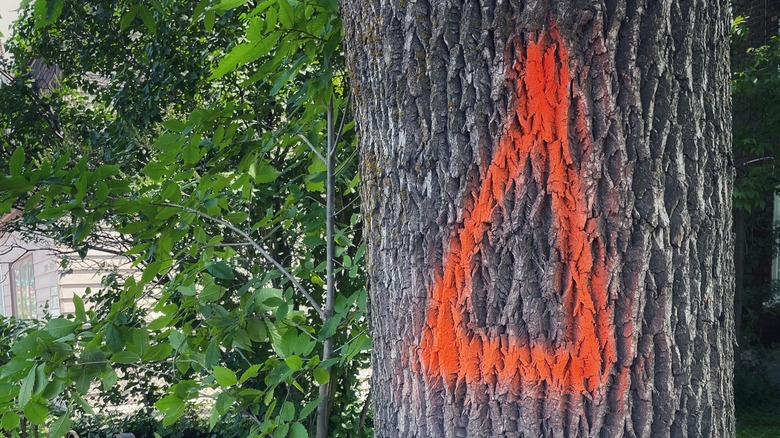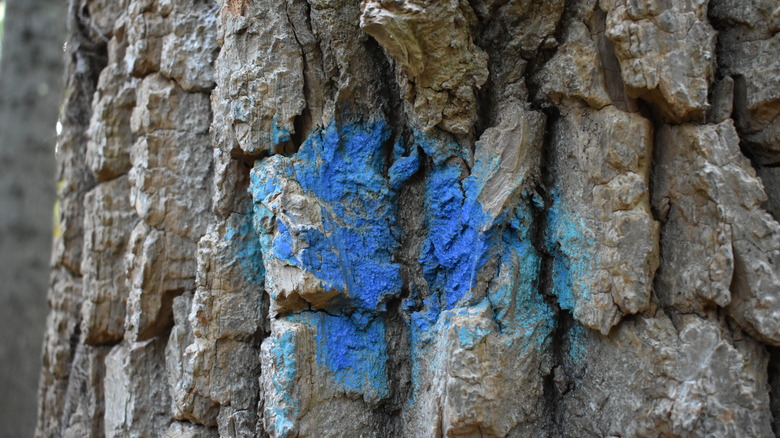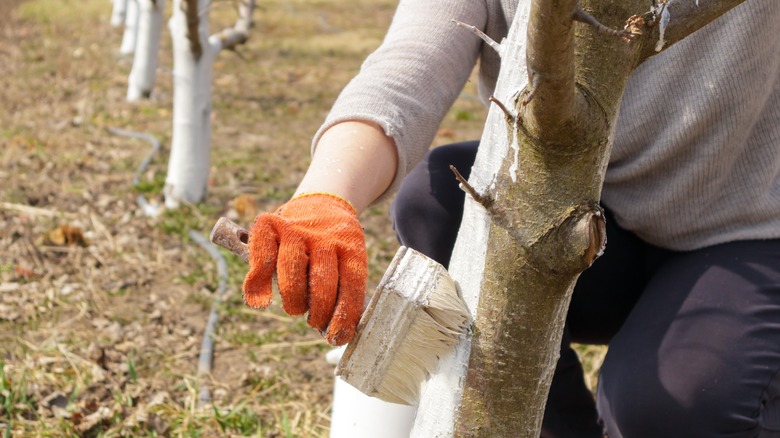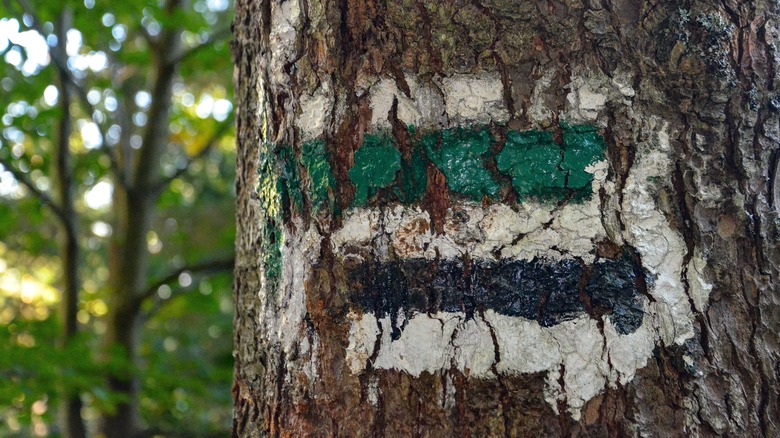What It Means When You See These Different Colors Painted On Trees
Paint marks on trees are one of those things where once you start noticing them, you suddenly see them everywhere. Colorful paint is used by individuals, tree professionals, and government agencies to mark trees for a wide range of reasons. Understanding what the different colors represent might seem interesting just because you're curious about the world around you. But more importantly, knowing what different paint colors represent could protect you from harm someday. The colorful markings you see on trees are often warnings designed to keep people from venturing onto land where they don't have permission to be.
There's one snag, though. Paint colors aren't used consistently from place to place. On one hand, certain marks on trees are generally going to mean the same thing in Maine that they do in Texas or Hawaii. However, your town's parks department might have its own system for marking public trees that's different than a neighboring town's system. And, there are also no standardized laws requiring all foresters to use specific colors to tag trees that need to be cut down. If you love to spend time out in nature, you're probably going to run into some trees with mystery markings. Having some background information and using context clues should help you decode a lot of the paint marks you see.
Red paint
If you notice a row of trees all marked with red paint, there's a good chance you're either in or near a national forest. The U.S. Forest Service, which manages 154 national forests in all, marks the boundaries between private and public property. Sometimes yellow signs with black writing are attached to trees at the edge of a national forest. In other cases, the Forest Service marks trees with horizontal lines of red paint. Special brands of paint are even produced for this purpose. They're designed to be waterproof, work on wet trees, and not soak into the wood.
Red paint is also sometimes used on trees in preparation for a timber sale. A licensed surveyor must mark the boundaries of the area that's involved in the sale before trees can be cut down. When that land is part of a larger property, a surveyor will often paint a red stripe on the trees around the border of the sale region. The paint is typically applied on one side of each tree, facing into the area of the timber sale.
Purple paint
Purple seems like kind of a fun and friendly color, right? And yet, it's the color of choice for people who want to keep people away. Painting trees at the edge of your property with the color purple means that it's private property and others shouldn't enter. You might notice purple paint on trees in wooded places where homes share borders with wilderness areas, for example. Sometimes purple tape or purple fabric is wrapped around a tree instead. Marking trees with bright purple is an easy way for a property owner to try to keep confused hikers or hunters from wandering off a trail and into their adjacent backyard.
Anyone can use purple paint to mark their own trees to try to keep trespassers off their land. It may not work, of course, if someone doesn't know what the paint represents. But in some states, using purple paint is actually a legally enforceable way to discourage trespassing. So-called purple paint laws are on the books in more than a dozen states. A few states have chosen colors other than purple to communicate no trespassing, however. In those states, anyone who ignores marked trees and trespasses on private property may be fined or face other legal consequences. Google your state's name and "purple paint laws" for any specific information about how and where paint markings must be used to be legally enforceable.
Orange paint
A slash of orange paint on a tree trunk is hard to miss even in a dark forest on a gloomy day. Because of its visibility, orange paint is applied to trees for a variety of purposes. Loggers and foresters preparing to cut down trees often use the color to identify the specific trees to be cut. Municipalities might use the color for the same reason, to mark trees on public land that need to be cut down for a variety of reasons.
Orange paint is sometimes used on trees to communicate a different message. A row of trees painted with orange lines might be a land boundary, as one example. And, in a few places, orange is used instead of purple to keep trespassers away. For example, in Arizona, state law tells individuals to mark the borders with signs and orange paint to prevent unauthorized hunting, fishing, and trapping on their property.
Blue paint
Blue paint is often used to denote boundary lines. A straight row of trees that are all painted with a blue stripe probably indicates the end of someone's property. So, if you see a tree that has blue paint marks, be respectful and avoid crossing the property owner's border.
And what if you spot a tree painted entirely blue, even the tips of its branches? It might be part of the Blue Tree Project, an Australian charity focused on mental health. It was founded by a woman whose brother, Jayden Whyte, died by suicide in 2018. After his death, people began to paint trees bright blue in his honor. The Blue Tree Project describes them as reminders to check in with friends and family who may be struggling. More than 1,000 blue trees have been painted to date. Most are in Australia but there are a handful in the U.S., and others spread out across the globe. (Anyone can paint a blue tree, assuming it's one they have the authority to alter, but the charity stresses that only dead trees should be painted.)
If you or someone you know is struggling or in crisis, help is available. Call or text 988 or chat 988lifeline.org
White paint
Sometimes you might see a lone tree or an entire group of trees with trunks painted white. This is usually done to young trees or trees with thin bark, to protect them from sunscald. You might also notice a tree in a wooded area marked with just a stripe or ring of white paint, but what that means depends on where you are. White is a highly visible color against dark brown bark. So, it's easy to see why it's sometimes chosen to mark hiking trails and for other purposes in wooded areas. (For example, in Florida's national forests, biologists apply white paint to trees where endangered red-cockaded woodpeckers are nesting.)
Is sunscald something you need to protect your trees from? Maybe, if you have any that are newly planted or have thin bark. Deciduous trees including beech, dogwood, sugar maple, and fruit trees are most vulnerable to sunscald. Sun exposure (or sun reflected off of snow) warms the bark during the day, which essentially "wakes up" dormant cells under the bark. When the temperature drops at night, those active cells die. This cycle can damage the bark and expose the tree to further vulnerabilities, such as an insect infestation. Painting trunks with white latex paint reflects the sunlight to prevent those temperature shifts from happening.
More paint colors
What does it mean if you see other colors like green, pink, yellow, or black painted on trees? In popular hiking areas, they might correspond to different trails. Another possible explanation is that you're seeing an example of your town or city's tree management system. Dots or other marks might be painted on trees to communicate something about the health or status of the tree. For example, the city of Evanston, Illinois paints different colored dots on elm trees that indicate the year each one was last tested for Dutch elm disease.
Because there's so much variation in the way different colors are used on trees, spotting a painted tree in your area could present a fun mystery to solve. Grab your (imaginary) detective cap and start digging. If the trees are managed by your municipal government, or you're in a wooded area staffed by people like park rangers, someone should have answers to your tree questions.

